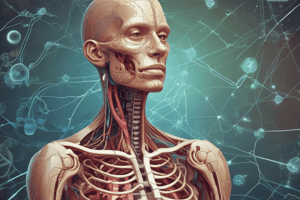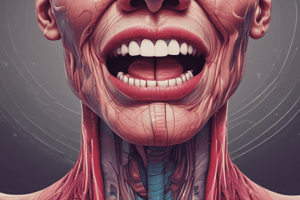Podcast
Questions and Answers
What is the surface that separates the anterior 2/3 and posterior 1/3 of the tongue?
What is the surface that separates the anterior 2/3 and posterior 1/3 of the tongue?
- V-shaped sulcus
- Fissure
- Terminal sulcus
- Sulcus terminalis (correct)
What type of epithelium covers the surface of the tongue?
What type of epithelium covers the surface of the tongue?
- Pseudostratified ciliated columnar epithelium
- Cuboidal epithelium
- Stratified squamous epithelium (correct)
- Stratified columnar epithelium
What is the function of the minor salivary glands in the tongue?
What is the function of the minor salivary glands in the tongue?
- Producing mucous secretions
- Producing serous secretions
- Producing both mucous and serous secretions (correct)
- Regulating tongue movement
Which major salivary gland is located in the cheek?
Which major salivary gland is located in the cheek?
What is the name of the minor salivary gland located in the submucosa of the tongue?
What is the name of the minor salivary gland located in the submucosa of the tongue?
What is the ventral surface of the tongue?
What is the ventral surface of the tongue?
Which of the following is NOT a major salivary gland?
Which of the following is NOT a major salivary gland?
What is the name of the papillae found on the surface of the tongue?
What is the name of the papillae found on the surface of the tongue?
What is the shape of filiform papillae?
What is the shape of filiform papillae?
Where are fungiform papillae primarily located?
Where are fungiform papillae primarily located?
What type of muscle makes up the tongue?
What type of muscle makes up the tongue?
How many types of lingual papillae are there?
How many types of lingual papillae are there?
Where are circumvallate papillae located?
Where are circumvallate papillae located?
What is the shape of fungiform papillae?
What is the shape of fungiform papillae?
Where are foliate papillae located?
Where are foliate papillae located?
What is the function of taste buds on lingual papillae?
What is the function of taste buds on lingual papillae?
Which type of papillae is described as "threadlike or cone-shaped"?
Which type of papillae is described as "threadlike or cone-shaped"?
Which type of papillae is described as "surrounded by a wall"?
Which type of papillae is described as "surrounded by a wall"?
Which type of papillae is described as "mushroom-like"?
Which type of papillae is described as "mushroom-like"?
Which type of papillae is described as "paperlike"?
Which type of papillae is described as "paperlike"?
Which type of papillae does not have taste buds?
Which type of papillae does not have taste buds?
What is the main function of serous acini?
What is the main function of serous acini?
Which of the following statements about taste buds is true?
Which of the following statements about taste buds is true?
Which type of papillae is the most numerous?
Which type of papillae is the most numerous?
What are the functions of taste buds?
What are the functions of taste buds?
Which type of cell in the taste bud is responsible for transmitting taste signals to the brain?
Which type of cell in the taste bud is responsible for transmitting taste signals to the brain?
Which of the following structures is NOT part of the general structure of the tongue?
Which of the following structures is NOT part of the general structure of the tongue?
Which of the following statements about taste buds is TRUE?
Which of the following statements about taste buds is TRUE?
Which of the following is a characteristic of dark staining cells in taste buds?
Which of the following is a characteristic of dark staining cells in taste buds?
Which of the following layers of the tongue contains glands and lymphoid nodules?
Which of the following layers of the tongue contains glands and lymphoid nodules?
Which of the following is a TRUE statement about the muscularis mucosa of the tongue?
Which of the following is a TRUE statement about the muscularis mucosa of the tongue?
Which of the following is a TRUE statement about the basal cells in taste buds?
Which of the following is a TRUE statement about the basal cells in taste buds?
Flashcards are hidden until you start studying
Study Notes
Tongue Structure
- The tongue has two main parts: the anterior 2/3 (body of tongue) and the posterior 1/3 (root of tongue), separated by a V-shaped sulcus terminalis.
- The body of tongue is divided into four regions based on embryologic origin.
Lingual Papillae
- There are four types of lingual papillae:
- Filiform papillae: coneshaped, numerous, and present all over the tongue, but has no taste buds.
- Fungiform papillae: mushroom-shaped, present on the tip and sides of the tongue, and has taste buds.
- Circumvallate papillae: located on the sulcus terminalis, surrounded by a wall, and has taste buds.
- Foliate papillae: large, circular papillae, present on the back of the tongue, and has taste buds.
Muscles of Tongue
- The tongue has skeletal muscles.
Salivary Glands
- There are three main salivary glands: parotid, submandibular, and sublingual.
- Minor salivary glands are present in the submucosa of the cheek (buccal gland) and tongue (labial gland).
Taste Buds
- Taste buds are onion-shaped structures in the epithelium of lingual papillae, such as fungiform papillae and circumvallate papillae.
- Function of taste buds: uncover the surface to feel food directly, stimulate gustatory nerve fibers, and receive sweet, salty, sour, and bitter sensations.
- Taste cells are pale-staining cells, while supporting cells are dark-staining cells.
Histological Structure of Tongue
- Mucosa: consists of epithelium, lamina propria (connective tissue), and muscularis mucosae (muscles of mucosa).
- Submucosa: consists of connective tissue containing glands, esophagus, duodenum, or lymphoid nodules in the ileum.
Subdivisions of Tongue based on Embryologic Origin
- The body of tongue is divided into four regions based on embryologic origin.
Studying That Suits You
Use AI to generate personalized quizzes and flashcards to suit your learning preferences.




